Back to Journals » Risk Management and Healthcare Policy » Volume 13
Occupational Health Conditions and Associated Factors Among Municipal Solid Waste Collectors in Addis Ababa, Ethiopia
Authors Melaku HS, Tiruneh MA
Received 15 August 2020
Accepted for publication 10 October 2020
Published 3 November 2020 Volume 2020:13 Pages 2415—2423
DOI https://doi.org/10.2147/RMHP.S276790
Checked for plagiarism Yes
Review by Single anonymous peer review
Peer reviewer comments 3
Editor who approved publication: Professor Marco Carotenuto
Henok Sileshi Melaku,1 Mesafint Abeje Tiruneh2
1Ethiopian Food and Drug Authority, Addis Ababa, Ethiopia; 2Bethzatha General Hospital, Addis Ababa, Ethiopia
Correspondence: Henok Sileshi Melaku Email [email protected]
Background: Municipal solid waste collection is one of the most dangerous jobs in the world. It exposes the workers to physical, biological, and chemical hazards, and occupation-related morbidities. In developing countries, municipal solid waste management-related occupational morbidities are not properly addressed. Therefore, the aim of this study was to investigate occupational health conditions and associated factors among municipal solid waste collectors in Addis Ababa, Ethiopia.
Materials and Methods: An institution-based cross-sectional study was conducted among 576 municipal solid waste collectors in Addis Ababa from August 2019 to September 2019. To select the study participants, a multistage sampling technique was used. The data were collected by using a structured interviewer administered questionnaire. The association between the dependent and independent variables was analyzed using binary logistic regression analysis at 95% confidence interval and variables with P-value< 0.05 were considered as statistically significant to the dependent variable.
Results: A total of 576 municipal solid waste collectors participated in the study, which makes the response rate 96.9%. Among the total municipal solid waste collectors, 295 (51.2%) of them had occupational health symptoms. Work experience (AOR=1.86, 95% CI=1.01– 2.18), family size (AOR=1.76, 95% CI=1.15– 2.71), personal protective equipment (AOR=2.31, 95% CI=1.32– 4.04), and working hours per day (AOR=1.76, 95% CI=1.22– 2.68) were significantly associated with occupational health conditions.
Conclusion: The magnitude of occupational health symptoms among municipal solid waste collectors in Addis Ababa was high. Work experience, working hours per day, type of PPE, and family size were significantly associated with occupational health conditions. Therefore, providing appropriate and full body cover personal protective equipment, giving training, monitoring working hours, and conducting studies including medical evaluation is crucial.
Keywords: municipal waste, waste collectors, occupational health, health conditions, Addis Ababa, Ethiopia
Introduction
Municipal solid waste collection is one of the most dangerous jobs in the world. It exposes the workers to physical, biological, and chemical hazards and exposes them to occupation-related morbidities. In developing countries, municipal solid waste management-related occupational morbidities are not addressed properly. The collection, transfer, treatment, recycling, recovery, and disposal of solid waste in urban areas is called municipal solid waste management (MSWM).1–4
The quantity and nature of waste fluctuate based on the level of technological advancement in a country. Municipal solid wastes are generated and discarded daily and can cause health problemd and environmental pollution if it is not collected, handled, and treated properly.5,6
The basic aim of integrated municipal solid waste management is to manage waste in accordance that meets public health and environmental concerns and the public’s interest to reuse and recycle the waste. An organized program for solid waste management in urban areas is essential, and institutional planning is the key to achieving a suitable and affordable system. The Municipal solid waste includes commercial and residential wastes produced in municipal or notified areas in solid or semi-solid form, including treated biomedical wastes, and excluding industrial hazardous wastes.6–8
Globally, municipal solid waste work has multiple health effects because of the need to lift, carry, pull, and push included in the loading–unloading process. The waste collection area is comfortable for insects, rodents, and scavenging animals, which have the potential for breeding of disease causative agents carriers.5,–9–11
It is also relocated from household containers into sacks or directly into a pushcart pushed to local gathering sites. Then, it will be manually dumped into a bigger container, then to a waste truck. Waste collectors are not properly protected.5,10 Municipal solid waste collection is a labor-intensive job characterized by a variety of manual tasks, including direct contact with waste.2
Municipal solid waste collectors in developing countries face occupational health problems such as muscle and ligament sprains, cuts and lacerations, and various allergies.12 Municipal solid waste collectors are exposed to occupational health problems due to long working hours; frequent work accidents, and exposures to chemical, physical, mechanical, and biological hazards which lead to physical and psychological illnesses.13 The major reasons for the existence of occupational health problems for municipal solid waste collectors in developing countries are the lack of protective equipment. This is mainly due to the inadequate allocation of budget for proper municipal solid waste collection. This leads to exposure to various health problems including developing diseases, being exposed to harmful infectious microorganisms, and musculoskeletal injuries including muscle damage, lacerations and cuts, and fractures.12
In many low-income countries, municipal solid waste is collected and sorted manually. Like other low-income countries, municipal solid waste in Addis Ababa city is being collected and sorted manually.5,7,14,15 The lack of providing modern waste management technologies and lack of providing appropriate trainings for municipal solid waste collectors and supervisers on occupational safety by Addis Ababa city Government Solid Waste Administration Agency, leaves solid waste handlers at risk of a number of occupational health risks. These workers have used less personnel protective equipment, and most municipal solid wastes are not safely contained in liftable load sizes. In addition to this, they cannot afford to get early checkups and treatment when they face any health problems. There is inadequate credible evidence on occupational health risks and associated factors in the city, which is vital for designing mechanisms to resolve the gap for concerned stakeholders.3,5,8 Hence, the aim of this study was to assess occupational health conditions and associated factors among municipal solid waste collectors in Addis Ababa, Ethiopia.
Materials and Methods
Study Design and Setting
An institution-based cross-sectional study was conducted in Addis Ababa from August 2019 to September 2019. Addis Ababa is home to 3,384,568 people, with an area of 540 square kilometers (54,000 hectares). The average elevation of the city is 2,500 meters above sea level. The city is organized by three hierarchies of government: city administration, sub-cities (10 sub-cities), and woredas (119 woredas). Currently a number of micro and small enterprises called “Shirkina” are engaged in participating in primary solid waste collection.5 There were about a total of 7,392 municipal solid waste collectors in Addis Ababa. (Source: City Administration of Addis Ababa Solid Waste Management Agency).
Study Population
All municipal solid waste collectors working in Addis Ababa.
Sample Size Determination and Sampling Procedure
A single population proportion formula was used to determine the sample size by considering 95% confidence level, 43.7% proportion and 5% marginal error, and double population proportion formula using Epi-Info statistical calculation and considering a one-to-one ratio and 80% power, design effect of 1.5, and 10% non-response rate based on a study conducted in Addis Ababa,5 and the largest sample size taken was 594.
To select the study participants, a multistage sampling technique was used. There were 74 small scale enterprises called “Shirkina” and 7,392 municipal solid waste collectors in Addis Ababa. Three sub-cities (30% of Addis Ababa sub-cities) were selected by simple random sampling technique. Therefore, by proportional allocation, 594 municipal solid waste collectors from three sub-cities were selected by simple random sampling technique from each sub-city proportional to the number of municipal solid waste collectors.
Study Variables
Study variables include occupational health conditions, socio-demographic characteristics, behavioral factors, past medical history, occupational and environmental factors, and institutional factors (Table 1).
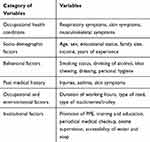 |
Table 1 Variables of the Study, Addis Ababa, Ethiopia, 2019 |
Operational Definitions
Occupational health conditions: The symptoms of any occupational health problems during the past year, like musculoskeletal symptoms, skin symptoms, or respiratory symptoms.
Chewing khat: Using khat leaves as a means of attaining a state of euphoria and stimulation, at least once a week.
Drinking alcohol: Using alcoholic drinks at least once a week to stimulate human feelings and excitement, which is described as a psychoactive drug.
Smoking status: Smoking of cigarette at least once a day (assume that if less than, it may not be related to their work) as a means of self-refreshment after engaged to this job and smoking until the time of data collection of this study.
Data Collection Procedures and Quality Assurance
Structured interviewer administered questionnaire (see the Supplementary Material) was used to collect the data. The questionnaire was prepared in English and translated to Amharic and later translated back to English to ensure consistency. The questionnaire was pretested on 5% of the sample size in another sub-city which was not included in the study prior to actual data collection. Before the actual data collection 1 day of training was given to the data collectors and field supervisor to ensure the quality of the data. Trained data collectors were recruited to collect the data on work site. One supervisor was supervising the data collection activities on the site.
Data Management and Analysis
The collected data were coded and entered into Epi-info version 7.0 software and exported to SPSS version 22.0 for analysis. Descriptive statistics was done. To screen out potentially significant variables, univariate binary logistic regression analysis was done at a 25% level of significance. Using the identified variables, multivariable binary logistic regression analysis was done to see the association between the dependent variable and independent variables at a 5% level of significance. Hosmer-Lemeshow goodness of fit test was used and the model fitted for the data (P=0.279). The assumption of multi-collinearity was checked and no multi-collinearity detected. Multivariable binary logistic regression analysis was done at 95% confidence interval and variables with a P-value<0.05 were considered as statistically significant.
Result
Socio-Demographic Characteristics
A total of 576 municipal solid waste collectors were included in the study, which makes the response rate 96.9%. Among the total study participants, 364 (63.2%) were males and 277 (48.1%) of the study participants were in the age group of 30–39 years. More than half of the study participants (326, 56.6%) were married. Two hundred and sixty-five (46%) of the study participants were grade 1–6. The mean monthly income of the study participants was 3,941 (SD=±1368) Ethiopian Birr. From the total study participants, 462 (80.2%) had no additional income. Most of the study participants (426, 74%) had four or less than four family members, and 378 (65.6%) of the study participants were permanent employees. Three hundred and twenty-eight (56.9%) of the study participants had worked 5 and less than 5 years as municipal solid waste collectors. From the total municipal solid waste collectors, around 438 (76%) worked more than 5 days per week (Table 2).
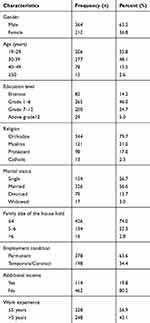 |
Table 2 Socio-Demographic Characteristics of Municipal Solid Waste Collectors in Addis Ababa, Ethiopia, 2019 (n=576) |
Institutional Factors
Four hundred and twenty-one (73.1%) municipal solid waste collectors fulfilled/provided PPE themselves. About 307 (53.3%) used gloves during work time. Only 109 (18.9%) of the study participants took occupational safety training. About 418 (72.5%) of the study participants did not get a periodical medical checkup within the last year, and the types of medical checkup that the other 158 (27.5%) respondents got were eye, respiratory, skin, and whole-body checkups (Table 3).
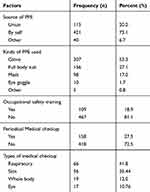 |
Table 3 Institutional Factors of Municipal Solid Waste Collectors in Addis Ababa, Ethiopia, 2019 (n=576) |
Behavioral Factors
From the total number of study participants, only 62 (10.8%) used PPE always, and the reasons for not using PPE were: 104 (67.9%) stated they cannot provide it by themselves; and 50 (30.1%) stated it was not comfortable for work. About 199 (34.5%) of the study participants were drunker and 117 (58.8%) of them started after joining this work. About 173 (30%) of the respondents chewed khat, from them 120 (69.4%) started after they started the work. About 94 (16.3%) of them were smokers and from these 57 (60.6%) started smoking after they joined this work; and 58 (10.1%) of the respondents had other addictions like coffee. About 425 (73.8%) of the study participants did not attend to their personal hygiene immediately after work (Table 4).
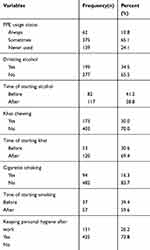 |
Table 4 Behavioral Factors of Municipal Solid Waste Collectors in Addis Ababa, Ethiopia, 2019 (n=576) |
Past Medical History
From the total study participants, 126 (21.88%) of the study participants had a past medical history, of which 45 (7.8%), 39 (6.8%), and 42 (7.3%) of them had a past medical history of skin symptoms, asthma, and injuries, respectively (Table 5).
 |
Table 5 Past Medical History of Municipal Solid Waste Collectors in Addis Ababa, Ethiopia, 2019 (n=126) |
Occupational and Environmental Factors
Among the total municipal solid waste collectors, only 115 (20%) of them responded that they used smooth road and only 380 (66%) of the study participants were working ≤8 hours per day. Only 138 (24%) of the study participants were working 5 or less than 5 days per week, and only 351 (60.9%) of the study participants used an easily movable trolley or pushcart (Table 6).
 |
Table 6 Occupational and Environmental Factors of Municipal Solid Waste Collectors in Addis Ababa, Ethiopia, 2019 (n=576) |
Occupational Health Conditions
Among the total municipal solid waste collectors, 295 (51.2%, 95% CI=47.1–55.4) had occupational health symptoms, and the remaining 281 (48.9%, 95% CI=45.0–52.8) had no occupational health symptoms. From those who had occupational health symptoms, 130 (45%) had respiratory symptoms, 101 (34.2%) had skin symptoms, and 63 (21.8%) had musculoskeletal symptoms.
Factors Associated with Occupational Health Conditions
Level of education, work experience, provision of PPE material, kinds of PPE used, family size, working days, working hours, keeping personal hygiene, types of machinery/trolley used, and type of road were significantly associated with occupational health conditions at 25% level of significance univariate binary logistic regression analysis. However, only family size, work experience, type of PPE, and working hours per day were significantly associated with occupational health conditions at 5% level of significance for multivariable binary logistic regression analysis.
Municipal solid waste collectors who had work experience greater than 5 years were 1.68-times more likely to have occupational health symptoms compared to those who had work experiences of 5 or less years (AOR=1.86, 95% CI=1.01–2.18).
Municipal solid waste collectors who had a family size of greater than four were 1.76-times more likely to have occupational health symptoms compared to those who had a family size of four or less (AOR=1.76, 95% CI=1.15–2.71).
Municipal solid waste collectors who used only a mask were 2.31-times more likely to have occupational health symptoms compared to those who used a fully body suit (AOR=2.31, 95% CI=1.32–4.04).
Municipal solid waste collectors who worked more than 8 hours per day were 1.81-times more likely to have occupational health symptoms compared to those who worked 8 or less hours per day (AOR=1.76, 95% CI=1.22–2.68) (Table 7).
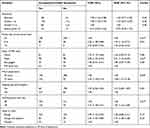 |
Table 7 Univariate and Multivariable Analysis for Factors Associated with Occupational Health Symptoms Among Municipal Solid Waste Collectors in Addis Ababa, Ethiopia, 2019 (n=576) |
Discussion
Among the total municipal solid waste collectors, 295 (51.2%) had occupational health symptoms in the last year, which could be considered as higher as compared to the studies conducted in Al Leith, Saudi Arabia (50%)16 and in four zones of Amhara Regional State, Northwest Ethiopia (34.3%).17 The reason for the high magnitude of occupational health symptoms in this study compared to other previous studies done might be due to the nature and type of municipal solid waste being collected and its quantity, the duration of time staying in the workplace, type of PPE used on duty, and the nature of the topography/road that the waste was being collected from in Addis Ababa.
This study showed that most municipal solid waste collectors suffered with different types of health symptoms such as respiratory symptoms (130 (45.0%)), skin symptoms (101 (34.2%)), and musculoskeletal symptoms (64 (21.8%)), which were higher than studies done in Central India (21% respiratory symptoms and 31.4% skin symptoms),18 in Hebron, Palestine (44.7% respiratory symptoms and 20.2% skin symptoms),6 and in Kathmandu, Nepal (13.8% respiratory symptoms and 15.5% skin symptoms).19 Similarly, a study done in Beni-Suef, Egypt, revealed that respiratory and skin symptoms were 18.1% and 13.8%, respectively.7 Another study conducted in Alexandria, Egypt, indicated that 3.2% and 2.3% of municipal solid waste collectors had musculoskeletal and respiratory symptoms, respectively.14 A study done in India indicated that 12.99% of solid waste collectors suffer from respiratory problems.12 Another study conducted in Latin America indicated that 14.3% and 78.8% of solid waste collectors suffer from respiratory problems and osteomuscular disorders, respectively.20 The reason for the higher magnitude in this study than other studies mentioned might be the absence of providing full body cover PPE, spending more working time on duty, and working as municipal waste collectors for long service years. But there was a study that showed a higher prevalence of respiratory, skin, and musculoskeletal health symptoms than this study. A study done by the World Bank Group in middle and low income countries showed that respiratory symptoms were 73% and musculoskeletal symptoms were 65%.3 The reason for the high magnitude in other studies compared to this study might be the higher number of study participants, covering large study areas, and the duration of the study time might be longer.
Municipal solid waste collectors who used only a mask were 2.31-times more likely to have occupational health symptoms compared to those who used a fully body suit. The reason for this is that much exposure might be due to working without using complete body cover PPE, which could expose the workers body to different kinds of occupational risk factors. The occupational health symptoms due to the absence of using a full body suit PPE were higher compared to the study done in Bahir-Dar city and Gondar town,21 but it was lower compared to the study done in Addis Ababa before 7 years and in Tamil Nadu, India, a study among street sweepers and sanitary workers.1
Municipal solid waste collectors who worked more than 8 hours per day were 1.81-times more likely to have occupational health symptoms compared to those who worked 8 or less hours per day. The reason being exposed this much might be the duration of time that they spent more time working on municipal solid waste collection activities. Similarly, studies conducted in Tamil Nadu, India1 and Bahir Dar and Gondar town21 showed that working hour per day was significantly associated with occupational health symptoms.
Municipal solid waste collectors who had work experience greater than 5 years were 1.68-times more likely to have occupational health symptoms compared to those who had work experiences of five or less than five years. The reason for exposure to occupational health risks might be due to staying for a long time as MSWC, which increases exposure to determinant factors. Similarly, studies conducted in Addis Ababa5 and Bahir Dar and Gondar town21 showed that work experience was significantly associated with occupational health conditions.
Municipal solid waste collectors who had a family size of greater than four were 1.76-times more likely to have occupational health symptoms compared to those who had a family size of four or less. The reason for this much exposure to occupational health risks might be due to spending most of their work time as MSWC to cover their large family expenses. This finding was higher than a similar study conducted in Addis Ababa seven years earlier.5
Conclusion
The magnitude of occupational health symptoms among municipal solid waste collectors in Addis Ababa was high. Work experience, working hours per day, type of PPE, and family size were significantly associated with occupational health conditions. Therefore, providing appropriate and full body cover personal protective equipment, giving training, monitoring working hours and conduct studies including medical evaluation is crucial.
Abbreviations
AAHB, Addis Ababa Health Bureau; AAMSWMA, Addis Ababa Municipal Solid Waste Management Agency; EFMHACA, Ethiopian food, Medicine and Health care Administration and Control Authority; FMOH, Federal Ministry of Health; HEWs, Health extension workers; OH, Occupational health; MSW, Municipal solid waste; MSWCs, Municipal solid waste collectors; SPSS, Statistical Product and Service Solutions.
Data Sharing Statement
All the data and materials are available in the manuscript.
Ethics Approval and Consent to Participate
As our institutions do not have the mandate to provide ethical clearance for research, ethical clearance was obtained from GAMBY Medical and Business College Ethical Review Board. Then a formal letter was written from the college to Addis Ababa City Administration Solid Waste Management Agency, and official permission obtained from Sub-Cities Beauty and Sanitation Agency offices. This study was conducted under technical support and supervision of GAMBY Medical and Business College. The study was also conducted in accordance with the Declaration of Helsinki. Written informed consent was taken from the study participants and all information was kept confidential.
Consent to Publish
Consent for publication was taken from the study participants during data gathering.
Acknowledgments
The authors would like to thank GAMBY Medical and Business College, Addis Ababa City Administration Solid Waste Management Agency, Sub-Cities, data collectors, supervisor, and study participants for their collaboration and contribution.
Author Contributions
Both authors meet the ICMJE criteria for co-authorship, providing substantial intellectual contributions for the manuscript. Both authors made substantial contributions to the conception and design, acquisition of data, or analysis and interpretation of data; took part in drafting the article or revising it critically for important intellectual content; agreed to submit to the current journal; gave final approval of the version to be published; and agree to be accountable for all aspects of the work.
Funding
The authors received no funding for this research.
Disclosure
The authors have no competing interests.
References
1. Joy P, Chitra AKJ. A cross-sectional study to assess the health profile of street sweepers and sanitary workers in a zone of Greater Chennai Corporation, Tamil Nadu, India. Int J Community Med Public Heal. 2018;5(10):4357–4362. doi:10.18203/2394-6040.ijcmph20183974
2. Shuvai C Occupational safety and health hazards associated with solid waste management in Bindura, Zimbabwe 2017:24–36.
3. Cointreau S Occupational and environmental health issues of solid waste management Special emphasis on middle- and lower-income countries 2006:10–18.
4. Endreddy E, Yasobant S. Musculoskeletal disorders among municipal solid waste workers in India: A cross-sectional risk assessment. J Fam Med Prim Care. 2015;4(4):519–521. doi:10.4103/2249-4863.174270
5. Bogale D, kumie A, Tefera W. Assessment of occupational injuries among Addis Ababa city municipal solid waste collectors: a cross-sectional study. BMC Public Health. 2014;14(1):1–8. doi:10.1186/1471-2458-14-169
6. Ahmad K Investigation of Occupational Health and Safety Hazards among Domestic Waste Collectors in Bethlehem and Hebron Districts. 2004:1–13.
7. Tefera W. Occupational Health-Related Morbidities Among Street Sweepers And Waste Collectors At Beni-Suef, Egypt. Egyptian Journal of Occupational Medicine. 2013;37(1):79–94. doi:10.21608/ejom.2013.773
8. Eliana G, Moacir D. Occupational safety and health in the screening of municipal solid waste in coop cidade limpa of Santo André. Rebrae Rev Bras Estrate?gia. 2014;7(3):263–280. doi:10.7213/rebrae.07.003.AO02
9. Decharat S. Prevalence of Adverse Health Effects among Municipal Solid Waste Workers, Southern Thailand. Int J Occup Hyg. 2017;9(4):186–191.
10. Kamal I The analysis safety and health risks of workers in the municipal solid waste landfill in Malaysia.
11. Abd A, Mohamed E-A, El-wahed AYA. Adverse Health Effects among Solid Waste Collectors in Alexandria Governorate. Int J Prev Med. 2018;5(2):23–48.
12. Thakur P, Ganguly RDA, Dhulia A. Occupational health hazard exposure among municipal solid waste workers in Himachal Pradesh, India. Waste Manag. 2018;78:483–489. doi:10.1016/j.wasman.2018.06.020
13. Zolnikov R, da Silva C, Tuesta A, Marques CP, Cruvinel VRN. Ineffective waste site closures in Brazil: A systematic review on continuing health conditions and occupational hazards of waste collectors. Waste Manag. 2018;80:26–39. doi:10.1016/j.wasman.2018.08.047
14. Ekram W, Abd E, Safaa M, Sameh E, Sanaa M, Hanan SAM. Adverse health problems among municipality workers in Alexandria (Egypt). Int J Prev Med. 2014;5(5):545–548. doi:10.5897/ajest2014.1851
15. Ekram W, Abd E, Safaa E. Seroprevalence of HBV among Egyptian municipal solid waste workers. Heliyon. 2019;5:1–6. doi:10.1016/j.heliyon.2019.e01873
16. Fouad M, Ahmed A. Occupational health and safety risks among the municipal solid waste collectors in Al Leith, Saudi Arabia. Eur Acad Res. 2018;5(11):9–10.
17. Eskezia D, Aderaw Z, Ahmed KY, Tadese F. Prevalence and associated factors of occupational injuries among municipal solid waste collectors in four zones of Amhara region, Northwest Ethiopia. BMC Public Health. 2016;16(1):5–12. doi:10.1186/s12889-016-3483-1
18. Patil PV, Kamble RK. Occupational health hazards in municipal solid waste collecting workers of Chandrapur city, central India. International Journal of Environment. 2017;6(1):46–57. doi:10.3126/ije.v6i1.16867
19. Marahatta S, Katuwl D, Adhikari SRK. Knowledge on occupational health hazard and safety practices among the municipal solid waste handler. JMMIHS. 2017;31(1):56–72.
20. Vanessa R, Carla P, Vanessa C, et al. Health conditions and occupational risks in a novel group: waste pickers in the largest open garbage dump in Latin America. BMC Public Health. 2019;19(581):1–15.
21. Gizaw Z, Gebrehiwot M, Teka ZMM. Assessment of occupational injury and associated factors among municipal solid waste management workers in Gondar town and Bahir Dar City, northwest Ethiopia. J Med Med Sci. 2014;5(9):181–192.
 © 2020 The Author(s). This work is published and licensed by Dove Medical Press Limited. The full terms of this license are available at https://www.dovepress.com/terms.php and incorporate the Creative Commons Attribution - Non Commercial (unported, v3.0) License.
By accessing the work you hereby accept the Terms. Non-commercial uses of the work are permitted without any further permission from Dove Medical Press Limited, provided the work is properly attributed. For permission for commercial use of this work, please see paragraphs 4.2 and 5 of our Terms.
© 2020 The Author(s). This work is published and licensed by Dove Medical Press Limited. The full terms of this license are available at https://www.dovepress.com/terms.php and incorporate the Creative Commons Attribution - Non Commercial (unported, v3.0) License.
By accessing the work you hereby accept the Terms. Non-commercial uses of the work are permitted without any further permission from Dove Medical Press Limited, provided the work is properly attributed. For permission for commercial use of this work, please see paragraphs 4.2 and 5 of our Terms.
